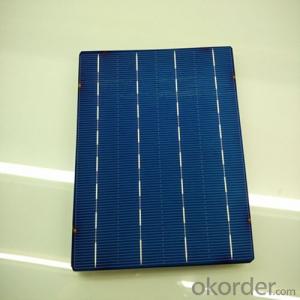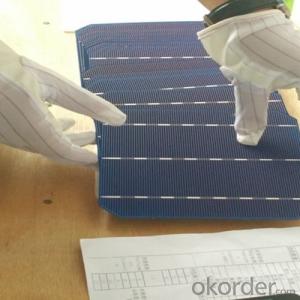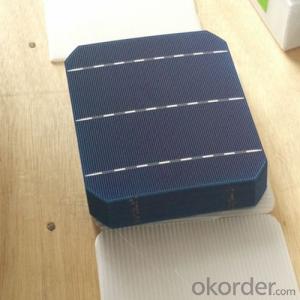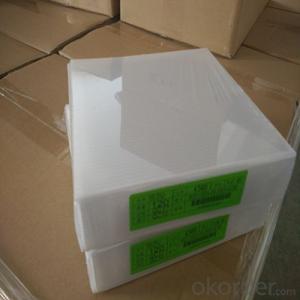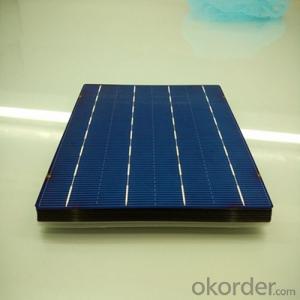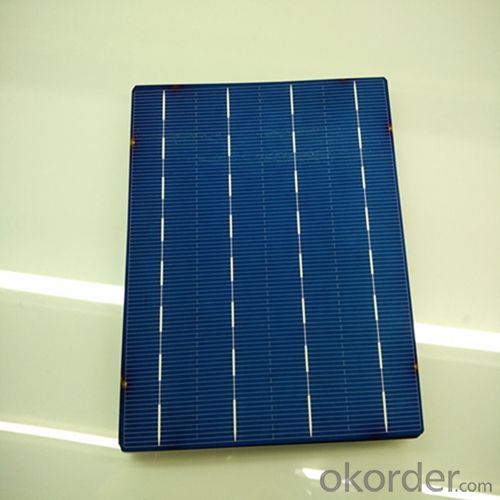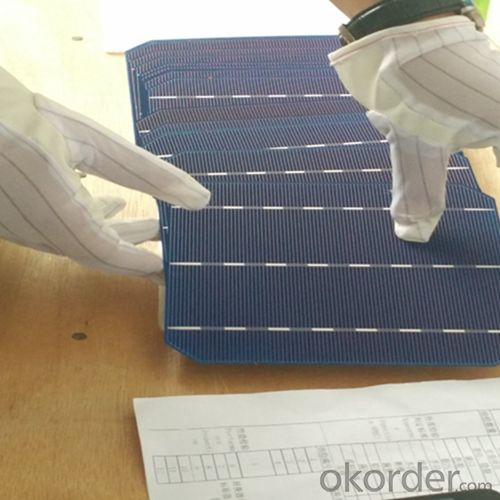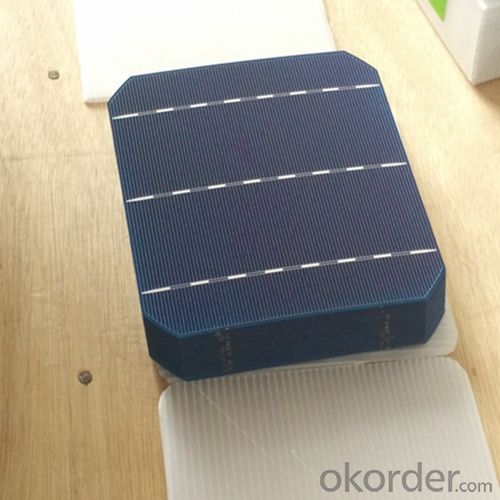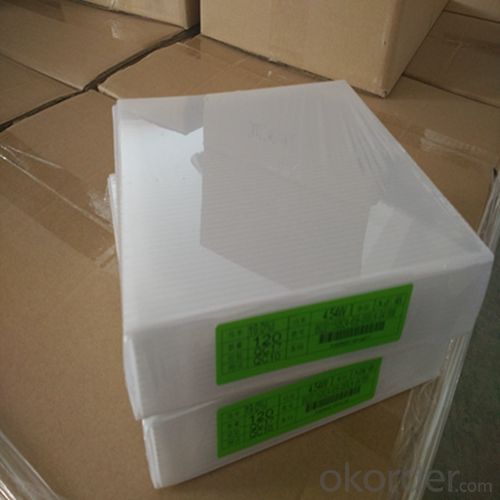Wholesale Solar Cells China - Poly 156x156mm2 Class A Solar Cells Made in China
- Loading Port:
- Shanghai
- Payment Terms:
- TT OR LC
- Min Order Qty:
- 5999 watt
- Supply Capability:
- 6000000 watt/month
OKorder Service Pledge
OKorder Financial Service
You Might Also Like
The operation of a photovoltaic (PV) cell requires 3 basic attributes:
The absorption of light, generating either electron-hole pairs or excitons.
The separation of charge carriers of opposite types.
The separate extraction of those carriers to an external circuit.
In contrast, a solar thermal collector supplies heat by absorbing sunlight, for the purpose of either direct heating or indirect electrical power generation from heat. A "photoelectrolytic cell" (photoelectrochemical cell), on the other hand, refers either to a type of photovoltaic cell (like that developed by Edmond Becquerel and modern dye-sensitized solar cells), or to a device that splits water directly into hydrogen and oxygen using only solar illumination.Characteristic of Mono 156X156MM2 Solar Cells
You are gaining energy independence - add battery backup power for even greater energy security
The cost of electricity is only going to rise – insure against that rising cost
Adaptive cells change their absorption/reflection characteristics depending to respond to environmental conditions. An adaptive material responds to the intensity and angle of incident light. At the part of the cell where the light is most intense, the cell surface changes from reflective to adaptive, allowing the light to penetrate the cell. The other parts of the cell remain reflective increasing the retention of the absorbed light within the cell.[67]
In 2014 a system that combined an adaptive surface with a glass substrate that redirect the absorbed to a light absorber on the edges of the sheet. The system also included an array of fixed lenses/mirrors to concentrate light onto the adaptive surface. As the day continues, the concentrated light moves along the surface of the cell. That surface switches from reflective to adaptive when the light is most concentrated and back to reflective after the light moves along
Mechanical data and design
Format | 156mm x 156mm±0.5mm |
Thickness | 210μm±40μm |
Front(-) | 1.5mm bus bar (silver),blue anti-reflection coating (silicon nitride) |
Back (+) | 2.5mm wide soldering pads (sliver) back surface field (aluminium) |
Temperature Coefficient of Cells
Voc. Temp.coef.%/K | -0.35% |
Isc. Temp.coef .%/K | +0.024%/K |
Pm.Temp.coef. %/K | -0.47%/K |
Electrical Characteristic
Effiency(%) | Pmpp(W) | Umpp(V) | Impp(A) | Uoc(V) | Isc(A) | FF(%) |
18.35 | 4.384 | 0.526 | 8.333 | 0.63 | 8.877 | 78.39% |
18.20 | 4.349 | 0.526 | 8.263 | 0.63 | 8.789 | 78.54% |
18.05 | 4.313 | 0.525 | 8.216 | 0.63 | 8.741 | 78.32% |
17.90 | 4.277 | 0.524 | 8.161 | 0.625 | 8.713 | 78.04% |
17.75 | 4.241 | 0.523 | 8.116 | 0.625 | 8.678 | 77.70% |
17.60 | 4.206 | 0.521 | 8.073 | 0.625 | 8.657 | 77.36% |
17.45 | 4.170 | 0.519 | 8.039 | 0.625 | 8.633 | 76.92% |
17.30 | 4.134 | 0.517 | 8.004 | 0.625 | 8.622 | 76.59% |
17.15 | 4.096 | 0.516 | 7.938 | 0.625 | 8.537 | 76.80% |
17.00 | 4.062 | 0.512 | 7.933 | 0.625 | 8.531 | 76.18% |
16.75 | 4.002 | 0.511 | 7.828 | 0.625 | 8.499 | 75.34% |
16.50 | 3.940 | 0.510 | 7.731 | 0.625 | 8.484 | 74.36% |
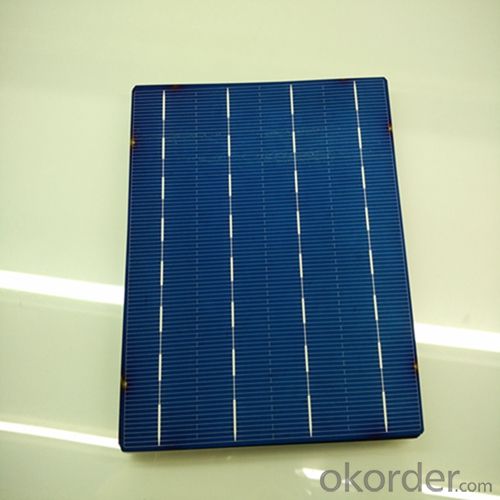
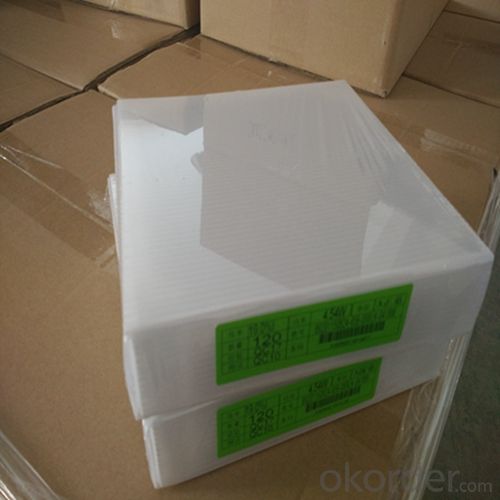
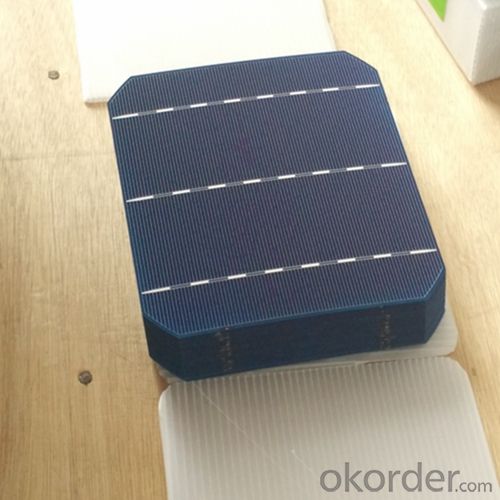
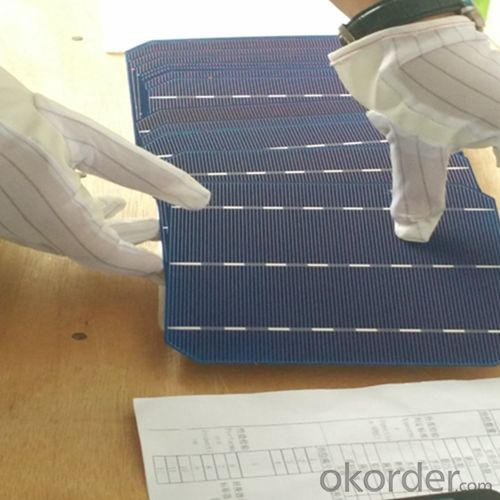
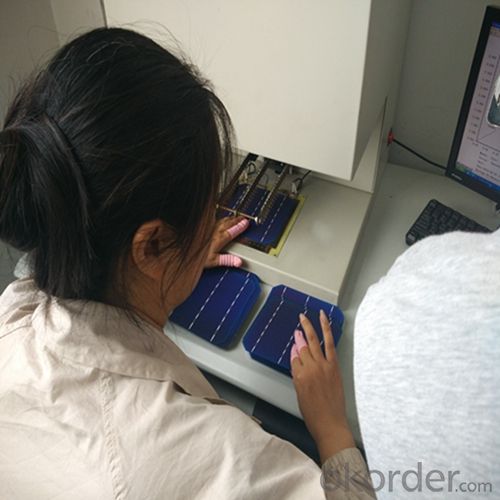 FAQ
FAQ
Q: What price for each watt?
A: It depends on the quantity, delivery date and payment terms, generally Large Quantity and Low Price
Q: What is your size for each module? Can you tell me the Parameter of your module?
A: We have different series of panels in different output, both c-Si and a-Si. Please take the specification sheet for your reference.
Q: What is your size for each module? Can you tell me the Parameter of your module?
A: We have different series of panels in different output, both c-Si and a-Si. Please take the specification sheet for your reference.
- Q: Where can I buy the 156x156mm high efficiency poly solar cells assembly?
- 156x156mm high efficiency poly solar cells assembly is usually very easy to get, all you need to do is to post your need online, and the suppliers will come to you.
- Q: Can solar cells be used to power electric fences?
- Yes, solar cells can be used to power electric fences. Solar cells convert sunlight into electricity, which can then be stored in batteries or used directly to power electric devices such as electric fences. This allows for a sustainable and reliable source of power, especially in remote areas where grid connection may not be feasible.
- Q: How does the solar cell work in terms of photochemical conversion?
- The photovoltaic cell module is capable of generating electromotive force when light is irradiated to obtain energy.
- Q: How do solar cells perform in areas with high levels of insect activity?
- Solar cells can still perform effectively in areas with high levels of insect activity. While insects may occasionally land on the surface of the solar panels, their presence does not significantly impact the overall performance or efficiency of the cells. Regular cleaning and maintenance can help ensure optimal function of the solar panels even in areas with high insect activity.
- Q: How to get high voltage, high current output of solar cells
- A reasonable series of parallel can be, and increase the number of sub-batteries
- Q: How do solar cells affect property value?
- Solar cells can positively impact property value by increasing its market appeal and attractiveness to potential buyers. The presence of solar cells signifies energy efficiency, lower electricity costs, and environmental consciousness, which are all desirable qualities in a property. Additionally, solar cells can potentially generate income through net metering or selling excess energy back to the grid, further enhancing the value of the property.
- Q: What is the impact of solar cell installations on property values?
- Solar cell installations generally have a positive impact on property values. Studies have shown that homes equipped with solar panels tend to sell for higher prices and at faster rates compared to homes without solar. The cost-saving benefits of solar energy, such as reduced electricity bills, attract potential buyers and increase the desirability of the property. Additionally, the environmental benefits associated with solar power contribute to the positive perception of the home, further boosting its value.
- Q: What is the impact of bird collisions on solar cell performance?
- Bird collisions can have a negative impact on solar cell performance. When birds collide with solar panels, it can cause physical damage to the panels, leading to reduced efficiency and power output. Additionally, bird droppings and debris from collisions can accumulate on the surface of the panels, further hindering their performance. Implementing preventive measures, such as bird deterrents or mesh covers, can help mitigate the impact of bird collisions on solar cell performance.
- Q: Can solar cells be used underwater?
- No, solar cells cannot be used underwater as they rely on sunlight to generate electricity. Water blocks sunlight and prevents the solar cells from functioning effectively.
- Q: Can solar cells be used on rooftops with different orientations?
- Yes, solar cells can be used on rooftops with different orientations. While the ideal orientation for maximum solar energy production is typically facing south, solar panels can still generate electricity when installed on rooftops facing east, west, or even north. The efficiency and energy output may be slightly lower, but advancements in solar technology and the ability to tilt and adjust panel angles can help optimize energy production on rooftops with varying orientations.
Send your message to us
Wholesale Solar Cells China - Poly 156x156mm2 Class A Solar Cells Made in China
- Loading Port:
- Shanghai
- Payment Terms:
- TT OR LC
- Min Order Qty:
- 5999 watt
- Supply Capability:
- 6000000 watt/month
OKorder Service Pledge
OKorder Financial Service
Similar products
Hot products
Hot Searches
Related keywords
